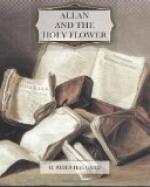I listened astonished to this harangue, which if it meant anything, meant that we had all met before, in Africa at some time when men used matchlocks that were fired with a fuse—that is to say, about the year 1700, or earlier. Reflection, however, showed me the interpretation of this nonsense. Obviously this old priest’s forefather, or, if one put him at a hundred and twenty years of age, and I am sure that he was not a day less, perhaps his father, as a young man, was mixed up with some of the first Europeans who penetrated to the interior of Africa. Probably these were Portuguese, of whom one may have been a priest and the other two an elderly man and his son, or young brother, or companion. The manner of the deaths of these people and of what happened to them generally would of course be remembered by the descendants of the chief or head medicine-man of the tribe.
“Where did we meet, and when, O Motombo?” I asked.
“Not in this land, not in this land, Father of Monkeys,” he replied in his low rumbling voice, “but far, far away towards the west where the sun sinks in the water; and not in this day, but long, long ago. Twenty Kalubis have ruled the Pongo since that day; some have ruled for many years and some have ruled for a few years—that depends upon the will of my brother, the god yonder,” and he chuckled horribly and jerked his thumb backwards over his shoulder towards the forest on the mountain. “Yes, twenty have ruled, some for thirty years and none for less than four.”
“Well, you are a large old liar,” I thought to myself, for, taking the average rule of the Kalubis at ten years, this would mean that we met him two centuries ago at least.
“You were clothed otherwise then,” he went on, “and two of you wore hats of iron on the head, but that of White Beard was shaven. I caused a picture of you to be beaten by the master-smith upon a plate of copper. I have it yet.”
Again he blew upon his horn; again a woman darted out, to whom he whispered; again she went to one of the chambers and returned bearing an object which he cast to us.
We looked at it. It was a copper or bronze plaque, black, apparently with age, which once had been nailed on something for there were the holes. It represented a tall man with a long beard and a tonsured head who held a cross in his hand; and two other men, both short, who wore round metal caps and were dressed in queer-looking garments and boots with square toes. These man carried big and heavy matchlocks, and in the hand of one of them was a smoking fuse. That was all we could make out of the thing.
“Why did you leave the far country and come to this land, O Motombo?” I asked.
“Because we were afraid that other white men would follow on your steps and avenge you. The Kalubi of that day ordered it, though I said No, who knew that none can escape by flight from what must come when it must come. So we travelled and travelled till we found this place, and here we have dwelt from generation to generation. The gods came with us also; my brother that dwells in the forest came, though we never saw him on the journey, yet he was here before us. The Holy Flower came too, and the white Mother of the Flower—she was the wife of one of you, I know not which.”




